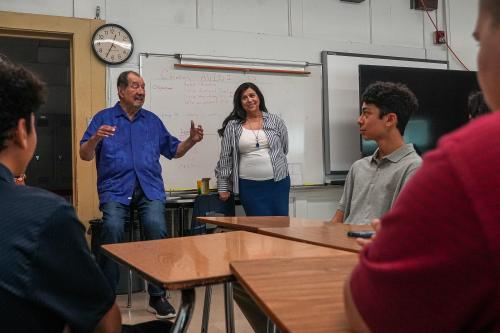This past Monday the Census Bureau released its new statistics on the nation’s children and school enrollment, and it showed something momentous. For the first time since this annual data series has been released, fewer than half of all the children (49.9 percent) in the youngest age group shown, three-year-olds, were white.
Whites still comprised a small majority of four-year-olds and increasing shares of older ages. Of those three-year-olds who did attend school—pre-k and kindergarten—whites were still in the majority. (Whites still comprise 58.8 percent of students of all ages.)
Yet these statistics finally confirm the beginning of an oft-predicted trend—a truly multiethnic minority school age population that will continue to pour into our grade schools, high schools, and beyond in the coming decade. The trend is most pronounced in eight states and the District of Columbia, where the pre-k and kindergarten populations are already minority majority. In an additional nine states, minorities—Hispanics, blacks, Asians, and other races—comprise over four in ten students (See table).
This tipping point comes in the midst of the state by state release of 2010 Census race-ethnic redistricting data which are likely to reinforce the picture of an increasingly multiethnic American youth. Each of the four states released thus far—New Jersey, Louisiana, Mississippi, and Virginia—showed absolute declines in their white youth (under age 18) populations since 2000. This may not come as much of a surprise in the two Gulf Coast states, which were ravaged by Hurricane Katrina—but it also applies to the other two more “suburban” states. According to the 2010 census, more than three-in-ten young people in New Jersey are either Hispanic or Asian, as is the case for more than one-in-six in Virginia.
And these are not isolated instances. An examination of the 2000–2009 trends from Census Bureau estimates suggests that we will see a decline in our white child population, both nationally and in some 40 states, when the complete 2010 census results are revealed. Only about half the states could show gains in their child populations in 2000 to 2010 period, and, in each of those, minorities will contribute all or most of those gains. In contrast, only four states could see a loss of whites in their over 18 population, and all will see white gains in the age groups over age 65.
These dramatic shifts in the child population result from the aging and low fertility rates of whites, coupled with immigration and often higher fertility rates of younger Hispanics and other minority groups. Today, most Hispanic growth is due to births to U.S. families rather than immigration.
Additionally, much of the demographic momentum for this change is already set in place.
Even if immigration stopped tomorrow, we will achieve a national minority majority child population by 2050 (by around 2023 if current immigration trends continue).
These shifts in the racial and ethnic profiles of our child population (and its contrast with the white baby boomer-inflated older adult population) present both opportunities and challenges.
In a world where other developed countries are struggling with aging populations and shrinking workforces (think Japan), we can be grateful for the contributions that waves of first, second, and third generations of Americans from Latin America, Africa, and Asia are poised to make. Their youth, vitality and new ideas will serve to reinvigorate our workforce and communities in ways akin to the positive influences of earlier immigrants and their descendants.
Yet, this dramatic transformation in our child and school-age populations should serve as a “wake up call,”—leading to a redoubling of quality education efforts for racial and ethnic groups with traditionally lower achievement rates in American schools—in a century where knowledge-based industry success is essential to national prosperity. There is also the need to heal political divisions associated with an emerging cultural generation gap, taking the form of punitive laws against immigrants, among other measures, as younger minorities disperse into new areas of the country.
Though these new numbers from the Census Bureau show a demographic “tipping point” among three-year-olds, time is already of the essence if we are to plan education reforms and other measures that will enable the members of this new youth wave to become productive, assimilated citizens in a competitive global economy.



Commentary
Op-edA Demographic Tipping Point Among America’s Three-Year-Olds
February 7, 2011